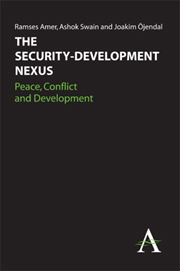Book contents
- Frontmatter
- Contents
- List of Tables and Figures
- List of Editors and Contributors
- Acknowledgements
- Chapter 1 Researching the Security-Development Nexus through a Multi-disciplinary Approach
- Chapter 2 Exploring the Security-Development Nexus
- Chapter 3 Liberal State-Building and Environmental Security: The International Community between Trade-Off and Carelessness
- Chapter 4 The Rising China and Maintaining the International Order: Some Reflections
- Chapter 5 Non-use of Force, Non-interference and Security: The Case of Pacific Asia
- Chapter 6 International Dimensions of Peace Processes in Aceh and Sri Lanka: The Role of Intermediaries in the 2000s
- Chapter 7 The Challenges of Human Security and Development in Central Asia
- Chapter 8 Diasporas' Role in Peacebuilding: The Case of the Vietnamese-Swedish Diaspora
- Chapter 9 Tracing Minerals, Creating Peace: The Security-Development Nexus in the DRC
- Chapter 10 Water Management and the Security-Development Nexus: The Governing of Life in eThekwini Municipality, South Africa
Chapter 5 - Non-use of Force, Non-interference and Security: The Case of Pacific Asia
Published online by Cambridge University Press: 05 June 2012
- Frontmatter
- Contents
- List of Tables and Figures
- List of Editors and Contributors
- Acknowledgements
- Chapter 1 Researching the Security-Development Nexus through a Multi-disciplinary Approach
- Chapter 2 Exploring the Security-Development Nexus
- Chapter 3 Liberal State-Building and Environmental Security: The International Community between Trade-Off and Carelessness
- Chapter 4 The Rising China and Maintaining the International Order: Some Reflections
- Chapter 5 Non-use of Force, Non-interference and Security: The Case of Pacific Asia
- Chapter 6 International Dimensions of Peace Processes in Aceh and Sri Lanka: The Role of Intermediaries in the 2000s
- Chapter 7 The Challenges of Human Security and Development in Central Asia
- Chapter 8 Diasporas' Role in Peacebuilding: The Case of the Vietnamese-Swedish Diaspora
- Chapter 9 Tracing Minerals, Creating Peace: The Security-Development Nexus in the DRC
- Chapter 10 Water Management and the Security-Development Nexus: The Governing of Life in eThekwini Municipality, South Africa
Summary
Purpose and Structure
The main purpose of the study is to investigate the linkages between some key dimensions of the Charter of the United Nations (UN) and the issue of security. This is done through an examination of two key norms of the charter: the prohibition of the threat or use of force in inter-state relations and the principle of non-interference in the internal affairs of states. The empirical application of these principles and their impact on regional security in the Pacific Asia region is examined through the study of the foreign policy of China and through the study of the principles governing the Association of Southeast Asian Nations (ASEAN). This is motivated by the fact that both China and ASEAN put strong emphasis on non-use of force in inter-state relations and on the principle of non-interference in the internal affairs of other states.
The study is structured in the following way. First, the key norms of the UN Charter relating the prohibition of the threat or use of force in interstate relations and the principle of non-interference in the internal affairs of states are identified, followed by a presentation of the debate that they have generated. Second, the empirical application of these principles and their impact on regional security is in the Pacific Asia is examined through the foreign policy of China and the principles governing ASEAN.
- Type
- Chapter
- Information
- The Security-Development NexusPeace, Conflict and Development, pp. 89 - 110Publisher: Anthem PressPrint publication year: 2012

